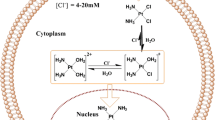Abstract
Lipophilic diaminocyclohexane (DACH) platinum complexes have shown significant promise in preclinical studies. One of these compounds,cis-bis-neodecanoato-trans-R,R-1,2-diaminocyclohexaneplatinum(II) (NDDP), which contains two branched leaving groups of 10 carbons, showed a favorable toxicity profile in a liposomal formulation in early clinical trials. However, like many other DACH platinum compounds with branched leaving groups, it is unstable within the liposomes, thus preventing its widespread clinical evaluation. We studied the effect of the configuration of leaving groups on intraliposomal complex stability by studying a series of DACH platinum complexes containing linear alkyl carboxylato leaving groups of 5–18 carbons. The entrapment efficiency was greater than 90% for all liposomal preparations of the complexes and was independent of lipid composition and length of the leaving group. The drug leakage from the liposomes was minimal, but was directly related to the length of the leaving group. Intraliposomal stability was inversely related to the length of the leaving group and the content of DMPG (dimyristoyl phosphatidylglycerol) in the liposomes. The effect of length of leaving group on intraliposomal stability was minimal in compounds with leaving groups smaller than 10 carbons, but very pronounced in compounds with longer leaving groups. Stable liposomal formulations of selected compounds with leaving groups of 6 and 10 carbons had significant in vivo antitumor activity against both L1210/S and L1210/PDD leukemias. The results indicate (1) that compounds with linear leaving groups are much more stable within DMPG-containing liposomes than compounds with branched leaving groups and (2) that DMPG is required for in vivo antitumor activity. Stable and active liposomal formulations of selected compounds with linear leaving groups have been identified. These formulations are candidates for clinical development.
Similar content being viewed by others
Abbreviations
- DMPC:
-
dimyristoyl phosphatidylcholine
- DMPG:
-
dimyristoyl phosphatidylglycerol
- L-NDDP:
-
liposomalcis-bis-neodecanoato-trans-1,2-diaminocyclohexaneplatinum(II)
References
Al-Baker S, Perez-Soler R, Khokhar AR (1993) Synthesis and characterization of a series of hydrophobic antitumor bis-(carboxylato) (1,2-diaminocyclohexane) platinum(II) complexes. J Coord Chem 29: 1–6
Burchenal JH, Kalaher K, O'Toole T, Chrisholm J (1977) Lack of cross-resistance between certain platinum coordination compounds in mouse leukemia. Cancer Res 37: 3455–3457
Gabizon AA (1992) Selective tumor localization and improved therapeutic index of anthracyclines encapsulated in long-circulating liposomes. Cancer Res 52: 891–896
Giandomenico CM, Abrams MJ, Murrer BA, Vollano JF, Barnard CFJ, Harrap KR, Goddard PM, Kelland LR, Mogan SE (1991) Synthesis and reactions of a new class of orally active Pt(IV) antitumor complexes. In: Howell SB (ed) Platinum and other metal coordination compounds in cancer chemotherapy. Plenum Press, New York London, pp 93–100
Han I, Ling Y-H, Al-Baker S, Khokhar AR, Perez-Soler R (1993) Cellular pharmacology of liposomalcis-bis-neodecanoato-trans-R,R-1,2-diaminocyclohexaneplatinum(II) (L-NDDP) in A2780/S and A2780/PDD cells. Cancer Res 53: 4913–4919
Jennerwein MM, Eastman A, Khokhar AR (1989) Characterization of adducts produced in DNA by isomeric 1,2-diaminocyclohexane-platinum(II) complexes. Chem Biol Interact 70: 39–49
Khokhar AR, Al-Baker S, Krakoff IH, Perez-Soler R (1989) Toxicity and antitumor activity ofcis-bis-carboxylato(trans-R,R-1,2-diaminocyclohexane)platinum(II) complexes entrapped in liposomes, a new series of lipid-soluble drugs. Cancer Chemother Pharmacol 23: 219–224
Loh SY, Mistry P, Kelland LR, Abel G, Harrap KR (1993) Mechanism of cisplatin resistance and its circumvention in human ovarian carcinoma cell lines. Proc Am Assoc Cancer Res 34: 399
Perez-Soler R, Khokhar AR (1992) Lipophilic cisplatin analogues entrapped in liposomes: role of intraliposomal drug activation in biological activity. Cancer Res 52: 6341–6347
Perez-Soler R, Khokhar AR, Lopez-Berestein G (1987) Treatment and prophylaxis of experimental liver metastases of M5076 reticulosarcoma withcis-bis-neodecanoato-trans-R,R-1,2-diaminocyclohexane platinum(II) encapsulated in multilamellar vesicles. Cancer Res 47: 6462–6466
Perez-Soler R, Lautersztain J, Wright K, Khokhar AR (1989) Preclinical toxicity and pharmacology of liposome-entrappedcis-bis-neodecanoato-trans-R,R-1,2-diaminocyclohexane platinum(II). Cancer Chemother Pharmacol 24: 1–8
Perez-Soler R, Lopez-Berestein G, Lautersztain J, Al-Baker S, Francis K, Macias-Kiger D, Raber MN, Khokhar AR (1990) Phase I clinical and pharmacological study of liposome-entrappedcis-bis-neodecanoato-trans-R,R-1,2-diaminocyclohexane platinum(II). Cancer Res 50: 4254–4259
Prestayko AW, Crooke ST, Carter SK (1980) Cisplatin-current status and new developments. Academic Press, New York
Schmidt W, Chaney SG (1993) Role of carrier ligand in platinum resistance of human carcinoma cell lines. Cancer Res 53: 799–805
Vadiei K, Siddik ZH, Khokhar AR, Al-Baker S, Sampedro F, Perez-Soler R (1992) Pharmacokinetics of liposome-entrappedcis-bis-neodecanoato-trans-R,R-1,2-diaminocyclohexane platinum(II) and cisplatin administered IV and IP in the rat. Cancer Chemother Pharmacol 30: 365–369
Author information
Authors and Affiliations
Additional information
The work reported in this paper was supported in part by NIH grants CA 41581, 45423, 50270, and 58342
Rights and permissions
About this article
Cite this article
Perez-Soler, R., Han, I., Al-Baker, S. et al. Lipophilic platinum complexes entrapped in liposomes: improved stability and preserved antitumor activity with complexes containing linear alkyl carboxylato leaving groups. Cancer Chemother. Pharmacol. 33, 378–384 (1994). https://doi.org/10.1007/BF00686266
Received:
Accepted:
Issue Date:
DOI: https://doi.org/10.1007/BF00686266




